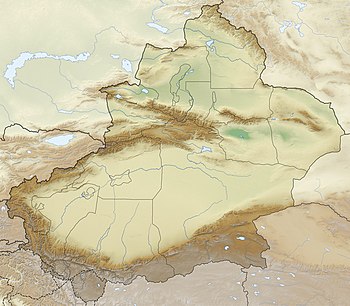Loulan
Democratic Republic of Loulan جمهوری دموکراتی تخارستان (jomhuri-e demokrâti-ye toxârestân) 樓蘭民主共和國 (lóulán mínzhǔ gònghéguó) | |
|---|---|
 Physical geography of Loulan | |
| Capital and largest city | Urabo |
| Official languages | Tokhari, Mandarin |
| Ethnic groups (2017) | |
| Religion (2005) |
|
| Demonym(s) | Loulani, Loulanese |
| Government | Unitary Constitutional Parliamentary Republic |
| Bhadra Kolite | |
| Punichandra Khashâyâri | |
| Legislature | Sansad-e Tokhârestân |
| Independence from China | |
• Declared | 20 December 1992 |
| Area | |
• Total | 1,664,897 km2 (642,820 sq mi) |
• Water (%) | negligible |
| Population | |
• 2019 estimate | 23,600,000 |
• 2010 census | 21,815,815 |
• Density | 13/km2 (33.7/sq mi) |
| GDP (nominal) | 2017 estimate |
• Total | $161.74 billion |
• Per capita | $6,680 |
| Gini (2015) | 46.2 high |
| HDI (2014) | high |
| Currency | Rupee (₹) (XJR) |
| Time zone | UTC+6:00 |
| Date format | dd/mm/yyyy |
| Driving side | right |
| Calling code | +86 |
| Internet TLD | .xj |
Loulan, officially the Democratic Republic of Loulan (Tokhari: جمهوری دموکراتی تخارستان jomhuri-e demokrâti-ye toxârestân; Chinese: 樓蘭民主共和國 lóulán mínzhǔ gònghéguó), is a sovereign state in Central Asia. Loulan is a landlocked country, dominated by the Dzungharian basin in the north, the Tarim basin in the south, and the Turpan depression in the east. It is split roughly between north and south by the Tian Shan mountains. It is bordered by China to the south and east, Mongolia to the northeast, Russia to the north, Kazakhstan to the northwest, Kyrgyzstan, Tajikistan and Afghanistan to the west, and Pakistan and India to the south. Its capital and largest city is Urabo.
The earliest known inhabitants of the area of modern Loulan were a caucasoid people, often with red or blonde hair, dating to at least the 2nd millennium BCE. Various nomadic peoples, such as the Yuezhi and Wusun of Chinese sources, were part of the migration of Indo-European speakers who settled in Central Asia (possibly as far east as Gansu) during that period. Although geographically isolated by its mountainous boundaries and highly variegated and often inhospitable terrain, which has helped to preserve its unique culture, Loulan has been at the crossroads of several great civilisations as part of the Silk Road and other commercial and cultural routes. It has long been dominated by foreign powers, in particular the Chinese, and attained sovereignty as a nation-state only after its independence from the People's Republic of China in 1992.
Since independence, Loulan has officially been a unitary parliamentary republic, although it has endured some internal conflicts and political strife. Loulan is a member of the Eurasian Economic Union, the Shanghai Cooperation Organisation, the World Assembly and the United Nations.
Ethnic Tokharis make up a small majority of the country's nearly 23 million people, followed by significant minorities of Han and Hui Chinese. The Tokhari language, also known as Tokhari Persian or Loulanese Persian, is a variety of the Persian language and the primary official language of Loulan, although Chinese remains widely spoken and is an official language — a legacy of government-sponsored Sinicisation during the administration of the People's Republic of China. The majority of the population follow either Mahayana Buddhism or traditional Chinese religion, although there is a significant Sunni Muslim minority and a small but historically significant Christian community. The culture of Loulan bears similarity to elements of Tibetan, Chinese, Mongolian, Persian, and Russian influence, in addition to its autochthonic heritage.
